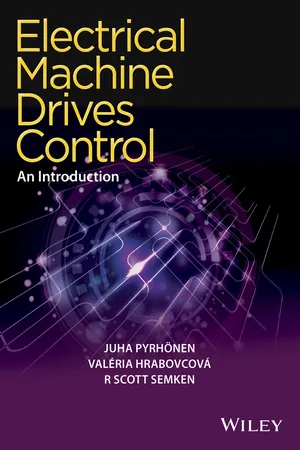
Electrical Machine Drives Control
An Introduction
- English
- ePUB (mobile friendly)
- Available on iOS & Android
About this book
This comprehensive text examines existing and emerging electrical drive technologies. The authors clearly define the most basic electrical drive concepts and go on to explain the most important details while maintaining a solid connection to the theory and design of the associated electrical machines. Also including links to a number of industrial applications, the authors take their investigation of electrical drives beyond theory to examine a number of practical aspects of electrical drive control and application. Key features: * Provides a comprehensive summary of all aspects of controlled-speed electrical drive technology including control and operation. * Handling of electrical drives is solidly linked to the theory and design of the associated electrical machines. Added insight into problems and functions are illustrated with clearly understandable figures. * Offers an understanding of the main phenomena associated with electrical machine drives. * Considers the problem of bearing currents and voltage stresses of an electrical drive. * Includes up-to-date theory and design guidelines, taking into account the most recent advances. This book's rigorous coverage of theoretical principles and techniques makes for an excellent introduction to controlled-speed electrical drive technologies for Electrical Engineering MSc or PhD students studying electrical drives. It also serves as an excellent reference for practicing electrical engineers looking to carry out design, analyses, and development of controlled-speed electrical drives.
Frequently asked questions
- Essential is ideal for learners and professionals who enjoy exploring a wide range of subjects. Access the Essential Library with 800,000+ trusted titles and best-sellers across business, personal growth, and the humanities. Includes unlimited reading time and Standard Read Aloud voice.
- Complete: Perfect for advanced learners and researchers needing full, unrestricted access. Unlock 1.4M+ books across hundreds of subjects, including academic and specialized titles. The Complete Plan also includes advanced features like Premium Read Aloud and Research Assistant.
Please note we cannot support devices running on iOS 13 and Android 7 or earlier. Learn more about using the app.
Information
1
Introduction to Electrical Machine Drives Control
1.1 What is an Electrical Machine Drive?
Table of contents
- Cover
- Title Page
- Copyright
- Preface
- Abbreviations and Symbols
- Chapter 1: Introduction to Electrical Machine Drives Control
- Chapter 2: Aspects Common to All Controlled Electrical Machine Drive Types
- Chapter 3: The Fundamentals of Electric Machines
- Chapter 4: The Fundamentals of Space-Vector Theory
- Chapter 5: Torque and Force Production and Power
- Chapter 6: Basic Control Principles for Electric Machines
- Chapter 7: DC and AC Power Electronic Topologies – Modulation for the Control of Rotating-Field Motors
- Chapter 8: Synchronous Electrical Machine Drives
- Chapter 9: Permanent Magnet Synchronous Machine Drives
- Chapter 10: Synchronous Reluctance Machine Drives
- Chapter 11: Asynchronous Electrical Machine Drives
- Chapter 12: Switched Reluctance Machine Drives
- Chapter 13: Other Considerations: The Motor Cable, Voltage Stresses, and Bearing Currents
- Index
- End User License Agreement